Free Influencer Marketing Series
Success! Enjoy the series Part 1: How an agency took a brand from 0 to $1MM in 4 months using influencers & ads
Free Influencer Marketing Series
Success! Enjoy the series Part 1: How an agency took a brand from 0 to $1MM in 4 months using influencers & ads

A lot goes into an influencer marketing program and you want to make sure you’re getting the results you’ve been hoping for. The only way to be sure is through effective influencer marketing reporting.
You need clear, rapid, and accurate reporting to understand what’s working versus what’s not. And whether you need to share the details with your clients or your boss, you need a report you can send over quickly and confidently.
Throughout this article, learn more about common issues we see brands and agencies face with influencer marketing reporting, why good reporting is so important, plus how to improve your reports.
Whether you’re reporting at the end of a campaign, end of quarter, or end of year, reporting is how you prove the value of influencer marketing. But many marketers have inefficient reporting processes. If your data is scattered across many spreadsheets, you’re likely wasting time and money, and missing the learnings that can propel your brand forward.
Learn more about the issues that can arise if you’re not providing accurate or efficient reports.

Some agencies spend as much as 3-4 hours per client per week on reporting. For agencies with, let’s say, 10 clients, that’s a collective 40 hours per week across all account managers, adding up to over 2,000 hours per year. That’s a full time job. Just spent on reporting.
Your account managers can’t focus on strategy or other critical tasks when they’re inundated with reporting tasks. While many brands and agencies are still trying to manage this task manually, there are better and more efficient ways to ensure your team isn’t overwhelmed by your reporting processes.
If it takes you or your team hours to put together a single report, how will you respond if a client or your boss requests an ad-hoc report? The entire day is thrown off, pushing important planned tasks off to another day.
Either that, or you simply cannot provide on-demand insights. Which doesn’t look great on you or your team and impacts decision-making. Brands and agencies should easily be able to handle these requests. Adjust your processes and bring in the right tools so that your team can quickly pull reports to address last minute requests.
Each campaign is an opportunity to learn and improve. Great reports will surface great questions and allow you to find the answers.
Can you easily mine for insights to understand which influencers performed best? And why did they perform best? What actions can you take based on the learnings? What can you test next time?
Let’s say your campaign engagement rate increased by 50%. What caused that? How can you repeat it, or improve it even more the next time?
Or, maybe 20% of your affiliates were responsible for 90% of your affiliate sales. What can you learn about the 20% – and do more of?
Having access to the reports is key. What reports do you need to help you find actionable insights to make your campaigns more effective? Here’s a start.
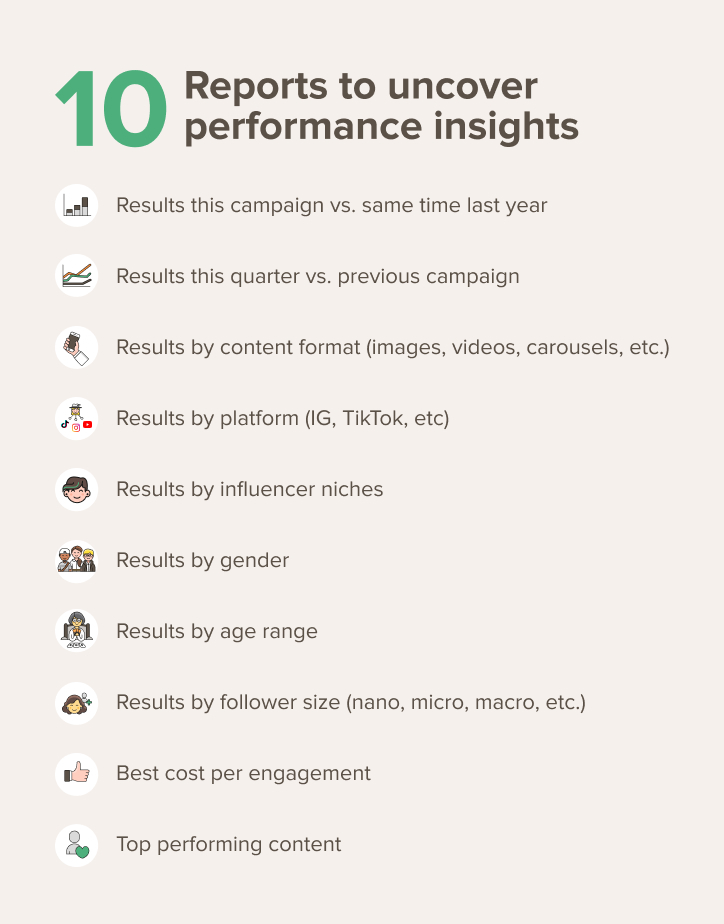
While reporting on individual campaigns is important, what about the big picture? When the client or the big boss wants to know why they’re investing so much in influencers, what do you show them?
“People want proof points to know why we're paying so many student influencers to do social media posting. So, we compare the reach, engagements and impressions that we're seeing as we continue to develop the program and add more student influencers. With MightyScout, it’s been easy to pull proof points and show why we spend the money on it.”
– Kiah Zellner-Smith, Multimedia Marketing Manager at IES Abroad
Bad data leads to bad decision making. When you invest in reporting, make sure your data collection process is producing accurate data to feed into reports. Spreadsheets are prone to human error.
It’s perfectly practical to use spreadsheets for data collection when you first start out with influencer marketing. But once you’ve proven the value of working with influencers, use a tool to capture data and content – for accuracy, speed of learning, and cost reasons.
Missing data is never a good thing. They lead to poor decision-making and your hard work going unnoticed.
Incomplete data typically stems from poor tracking processes. Some types of influencer content and metrics are especially prone to tracking difficulties.
Take Stories, for instance. They are a favorite influencer marketing format–but they disappear in just 24 hours. Do you expect your team to work on weekends and holidays to manually capture them?
Or, unpaid collabs like product seeding, gifting and events. They are the poster child for “hard to track” content. Automation is a lifesaver when you finally find a tool that tracks reliably.
Speaking of reliability, even if you are using a third-party tool, be sure to audit for reliability. If you sense some missing data, do a quick audit. That is, track stories by hand for a day and see if your automation is doing its job.
If it seems like there’s a lot of value to be missed – there is. Missed data points add up and understate the impact of your campaigns.
If your team doesn’t understand what they’re reporting on and isn’t properly trained in analyzing their reports, they’ll lack clarity and confidence as they share their data. A team focused on collecting the data, doesn’t have as much time to learn from it.
32% of social media marketers report to their leadership teams weekly. That provides a lot of opportunities to build trust with leadership or be doubted.
Marketers need easy-to-understand reports that they can confidently share with clients or team leaders. They need reports that help them make recommendations for improvement. A patchwork of spreadsheets isn’t providing that.
Now that we’ve seen some of the issues caused by bad reporting, let’s take a look at why comprehensive influencer marketing reporting is so important.
The best influencer marketing reporting tools offer performance metrics that can be used at multiple levels.
When you present quarterly or annually to that high level boss or client, you want to show how influencer marketing is impacting the bottom line. You want to provide a high level view of your campaigns and influencer activity for a time period wrapped up in a nice bow.
For Kiah Zellner-Smith, growing her student influencer program at IES Abroad resulted in a 37% increase in student applications. That’s the high level view top leadership wants to see.
You’ll want to show your high level impact at performance review time and when you’re planning to ask for more influencer marketing budget. A whopping 59.4% of survey respondents plan to increase their influencer marketing budget in 2024, according to Influencer Marketing Hub’s 2024 Benchmark Report.
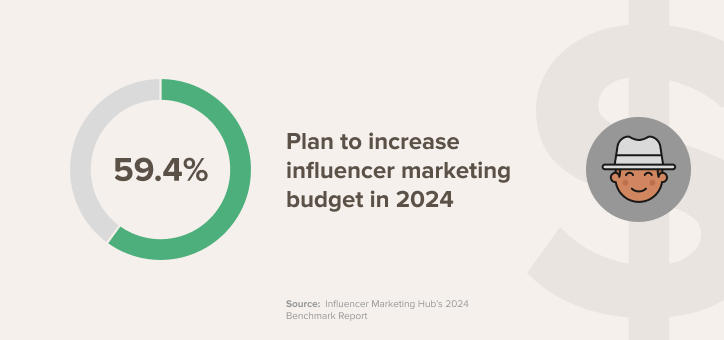
Wrapping up campaign results and documenting learnings is how you continually improve. This level of reporting is important for those executing the work and their team lead.
The details included in your report will depend on your campaign’s main objectives. You’ll want to include the most pertinent details so the team has a complete look into the campaign’s performance.
Here’s an example of when you would use two different sets of metrics, based on different goals.
Let’s consider two product seeding campaigns with different goals. The first aims to start influencer relationships and produce unique content to use in ads. The key metrics are:
Number of influencers invited
Number and % of influencers opted in
Number of posts and % of influencers posting
Number of content assets with rights
Engagement
Another brand uses product seeding campaigns to produce awareness. The key metrics for this brand are:
Number of influencers invited
Number and % of influencers opted in
Number of posts and % of influencers posting
Total impressions and reach
Engagement
Followers gained
The details included in your report will depend on your campaign’s main objectives. You’ll want to include the most pertinent details so the team has a complete look into the campaign’s performance.
A clear and concise influencer campaign report helps your readers discover key data like your campaign’s ROI, if it was successful, if you want to work with some of the involved influencers again.
According to Influencer Marketing Hub’s benchmark report, a surprising 30% of influencer marketing firms don’t report ROI at all.
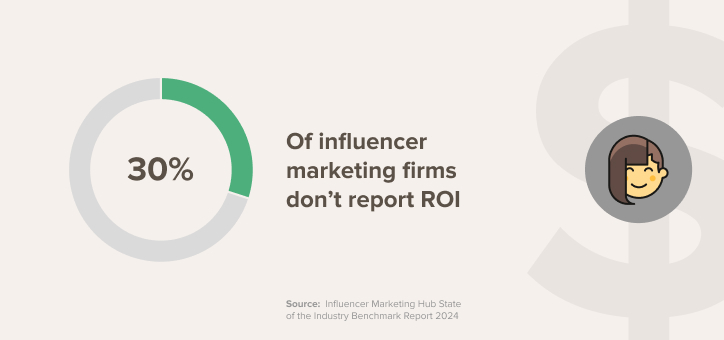
Without clearcut numbers like ROI, how do you make good decisions about where to spend your marketing budget?
When your client or CEO asks why a certain result is trending up or down, you’ll be glad you have each influencer’s data at your fingertips. Spreadsheets won’t help you find insights easily.
Insights helped Kiah at IES Abroad take work off her plate. She noticed the student influencers’ content far outperformed the TikTok ad creatives she was producing in-house. With that insight, she shifted her strategy to use only the influencer content for her TikTok ad creatives.
Now let’s get to the good stuff. How can you improve your influencer marketing reporting process so that your reports are accurate, effective, and properly reflect your ROI?
We’ve got eight steps to help you start putting together an efficient and comprehensive reporting process.
Remember more data doesn’t mean more insight. We included a lot of information that could be in an influencer marketing report above. But we also mentioned a caveat: the details within a report should depend on the campaign’s goals and objectives.
A campaign based on brand awareness doesn’t need information about clicks or conversions. A campaign based on sales doesn’t need to include information like followers gained.
Including data for the sake of including data doesn’t provide more insight. In fact, more data can be more confusing.
Focus on quality data over quantity. You don’t need to include every single possible KPI in your report—only those pertinent to a campaign's goals.
Set yourself up for success by establishing clear goals for your influencer marketing campaign. This guides you to include only the necessary metrics and KPIs in your report, rather than irrelevant data.
Let’s cover some common influencer marketing campaign goals and the KPIs you’d track and report for each one.
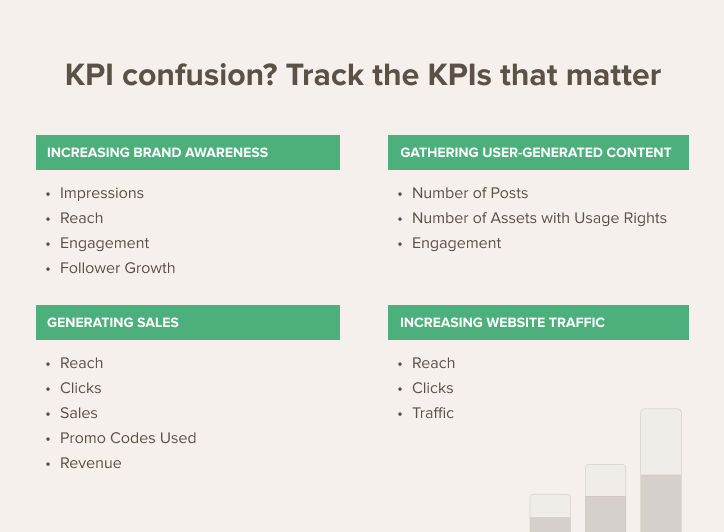
Make sure to select only the most relevant metrics to track and include in your report.
If you rely on your people to capture and track content, it’s critical to set up processes to do this daily. Be sure to monitor influencer accounts 7 days per week, including holidays and vacations. Otherwise you will miss the valuable Stories that disappear after 24 hours.
One of the best ways to improve monitoring and tracking is to find a tool that can automate tracking so you never miss a beat. MightyScout, for example, has the perfect influencer tracking tools to help you keep a close eye on the progress of every campaign you run.
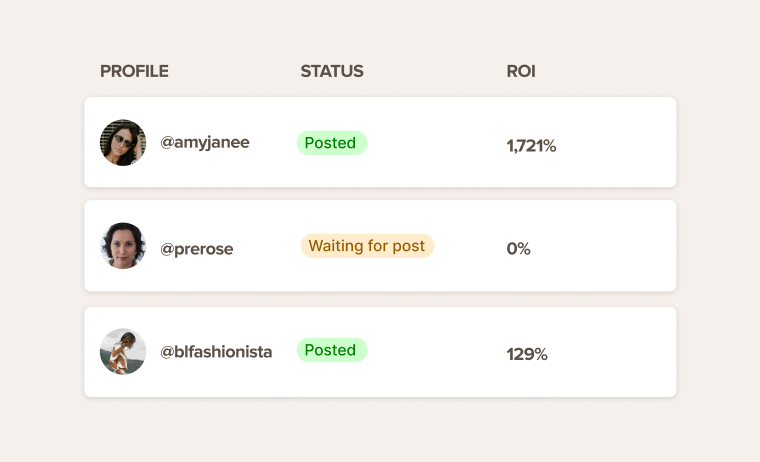
With MightyScout, automation will let you know when influencers post, and it captures the content and updates metrics multiple times per day.
An influencer tracking template is different from your overall reporting template, which we’ll cover in step seven. This spreadsheet enables you to keep track of each influencer you’re interested in working with, in talks with, and in the middle of a campaign with.
Create a spreadsheet with three main pages:
Outreach: Includes an overarching list of every influencer you think would be a good fit for your product/service, their social media platforms, contact information, and whether you’ve reached out to them or not.
In Talks: Includes a list of every influencer you’re currently in communication with regarding a partnership or campaign. You can include steps here, like “Contract Signed,” “Product Shipped,” “Product Received,” and more. You can even include an option that lets you know if an influencer has declined working with you or if they’re currently out of your budget so you know to cease communication or reach back out at a later time.
Campaign: Includes a list of every influencer you currently have in a live campaign. You may consider creating a separate page or a separate column for each campaign so you can seamlessly keep track. Include fields that let you share links to their posts for your brand as well as keep track of its performance throughout the campaign.
Keeping a tracking spreadsheet like this can help make the end-of-campaign or weekly reporting process much more seamless. Set up processes around keeping it updated so you can easily extract its data for your reporting.
Tools and software are your friends when it comes to running a well-oiled influencer marketing campaign. Tools that can help with many different tasks:
Discovery
Outreach
Tracking
Planning
Reporting
MightyScout itself offers a number of influencer marketing-related features, like:
Social Listening
Influencer Discovery
Influencer & Direct Messaging Management
Product Gifting & Shipping
Influencer Tracking
Reporting
Finding the right stack of software can help make easy work of running campaigns—and in turn, reporting on them.
We’ve already talked about how your metrics and KPIs should line up with your goals. However, that doesn’t mean that each metric needs to make it to the final report. Your client, team lead, or C-Suite doesn’t need every measured metric.
Instead, they want to see the big picture metrics and the campaign results. Those that impact their bottom line. How many potential new customers does the brand have? How many sales and how much revenue can they attribute to these influencer partners?
And most importantly, what’s the exact ROI (or return on investment) of the campaign as a whole? Is it a net positive or a net negative? And what recommendations does your team have for improving this in the future?
Now, you’re getting ready to finalize your report. Creating a reporting template helps you to stay organized and ensure your reports look cohesive—especially if you’re regularly handing them out or presenting them to clients.
Your tracking template that you created back in step four is more for internal use. It doesn’t need to look pretty—it just needs to hold data and help get the job done.
Your final reporting template, though, should be informative and visually appealing. Include your company or agency branding, put it in a presentation format to make it easier to read through, and consider working with a designer to create the template.
The reporting template doesn’t have to be long and in-depth. Just highlight the campaign objectives, performance, and results.
You can get started with a template we’ve made for you here.
Another option is to take advantage of an automated reporting tool. Influencer marketing reporting tools like MightyScout enable teams to export their data into ready-to-present white-label reports. MightyScout’s clients have shared their own success stories about how automated reporting and other tools have saved them tons of time and money.
For example, rideshare app Bolt shared details about how their small influencer marketing team could only pull together basic reports that didn’t dive deep into analytics with the time they had. Thanks to MightyScout’s reporting tools, they can.
“The most important part is not just the hours saved. Before MightyScout, we didn’t have the option to make the good decisions that we’re able to make now. Now that we have the option to calculate ROI, we have an option to have better forecasts.” – Mykhailo Kudla, Head of Distribution Marketing at Bolt
Take advantage of MightyScout—or the reporting tool of your choice—to help pull together cohesive and complete reports that enable you to dive deep into the results and understand what they mean, rather than scanning top-level numbers without the full scope.
Inefficient reporting can ruin your agency’s reputation or hinder your brand’s influencer marketing campaigns. Stop wasting time and money with unclear and inaccurate reports.
By using our eight-step guide above, you can easily improve your influencer marketing reporting, once and for all. And as a bonus, MightyScout’s influencer reporting tools can help. Learn more about incorporating MightyScout into your reporting process with a personalized demo.